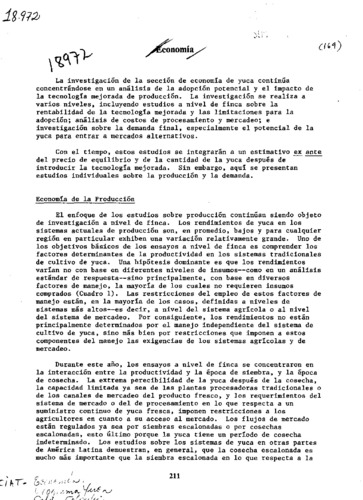Economia
During 1981 the analysis of the potential adoption and impact of improved cassava production technology was continued at various levels and included: farm-level studies of the profitability of improved technology and constraints to adoption; analysis of costs of processing and marketing; and research on final demand, especially the potential of cassava to enter alternative markets. Major determinants of yield in the cassava cropping system and other factors related to farming and marketing systems and their interaction with var. and climate are given. Cassava is harvested earlier than may be considered optimum due to constraints of marketing and labor availability. The effect of planting date on yield and profitability of cassava in high- management expt. was studied in 4 regions of Colombia (Media Luna, Mondomo, Socorro, and the Llanos) with different var.; different marketing strategies used by the farmers are described. Var. Barranquena and Sata Dovio are considered suitable for the fresh market, while Algodona and CMC 92 are considered only suitable for industrial use. Min. quality characteristics necessary to enter the fresh market may beconsidered to be 33 percent DM or more and 100- 200 ppm HCN or less. Recommendations include the development of dual-purpose var. with the requisite quality characteristics, the use of improved technology for local var., and specialization of production for the fresh market or processing depending on the area (prime land or marginal areas). The impact of new technology on the consumption of CF by the different income groups in Brazil was studied. In the feed concentrate market cassava can increase its production to fill the demand for raw material in different Latin American countries. (CIAT)

